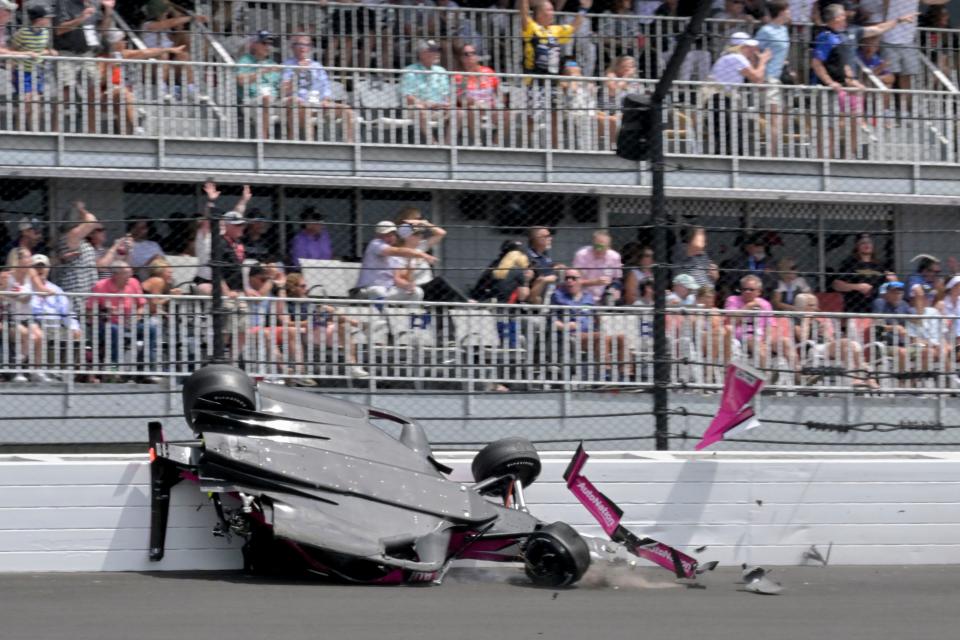After wheel flew over IMS fence, Doug Boles confident upgrade, not higher fences, right fix
INDIANAPOLIS – The Indianapolis Motor Speedway hasn’t had a fan fatality in more than 35 years but a “freak accident” – a mechanical failure that veteran officials at IndyCar’s chassis supplier called “an unusual and never experienced set of circumstances” – in last year's Indianapolis 500 put that mark at serious risk.
But after Kyle Kirkwood’s left-rear wheel was launched over the top of the Turn 2 catch fencing, over the grandstands and into the parking lot, where it smashed into (and totaled) the white Chevy Cruze of fan Robin Matthews, IMS president Doug Boles remains confident the track, the chassis and parts supplier and the IndyCar series have done their part to ensure no such “freak accident” can happen again.
And if you sit in or around the Turn 2 grandstands, you won’t notice any new or higher fencing, Boles told IndyStar. Penske Entertainment’s response, instead, revolves around a new part that IndyCar and Dallara officials believe will protect against a similar mechanical failure in the future.

“The fences we have now, over time, have gotten taller, and the overhang is larger, and I think if you compared us to other racetracks, if we aren’t better, we’re certainly equal,” Boles told IndyStar in an interview earlier this year detailing the various upgrades Penske Entertainment has made in and around the track over the last 12 months. “The comfort that we got was in Dallara’s review of what happened in that incident and how they could prevent it in the future.
“First of all, it was a freak thing, as most of these things tend to be. But secondly, I think everyone felt really comfortable that (Dallara’s responsive mechanical upgrade) had eliminated that kind of risk.”
More: IndyCar issues updated part after review of Kirkwood's flying wheel in 500 crash
With 20 laps to go in last year’s 500, Arrow McLaren’s Felix Rosenqvist got loose seconds after being passed by Josef Newgarden, and the Swede eventually drifted up into the outer wall. His No. 6 Chevy then drifted down the track after the initial hit, spun, and then drifted back up to a point where Andretti Global’s Kyle Kirkwood had nowhere else to go. His No. 27 Honda clipped the back of Rosenqvist’s car.
That particular hit, with the proper combination of speed, force and direction, “shredded” the connection point between Kirkwood’s left-rear wheel hub/wheel and his car’s suspension, pushrod and steering arm: the left-rear upright assembly. The crowd around the incident gave a collective shriek of surprise and bewilderment as the wheel cleared the Turn 2 fence and grandstands.
The initial suspicion was that the wheel's tethers had failed, though that was proven incorrect by series officials in the days after the crash. The tethers, woven strands of Zylon used to keep wheels attached to the chassis in the event of a crash, had been both strengthened and had their life cycles shortened ahead of the 2023 IndyCar season.
The series began mandating wheel tethers in 1999 after a tire came loose and hopped a 15-foot fence during the Indy Racing League’s May 1, 1999 visit to Charlotte Motor Speedway. Three spectators were killed that day and others were injured. Later that month at IMS, several wheels came loose during practice crashes that sent them dangerously bouncing around the track. One even nearly landed on top of driver John Paul Jr.
The year prior, a dislodged tire during CART’s July 26, 1998 race at Michigan International Speedway also soared into the grandstands and killed three spectators while injuring six others.
'That's the scariest thing': Roger Penske, IndyCar investigating cause of loose wheel in 500
The addition of wheel tethers have made such horrors essentially non-existent – at least until last May. Boles and others, though, insist that IndyCar’s new rear-wheel bearing retaining nut, distributed to all teams last summer in time for the next oval race immediately following the 500, should eliminate any worries of something similar happening again. Inserting higher fencing – in this case, much, much higher, given the heights Kirkwood’s wheel reached a year ago – would be guarding against a scary, though unlikely, scenario, rather than get to the root cause.
The topic, though, did prompt Boles to envision what the next generation of IMS fencing could look like.
In situations like last year’s, small pieces of debris spraying from such a vicious crash can – and do – still fly through the tiny chain-link fence-sized holes in the outer fencing positioned between the grandstands and the SAFER barriers. In the immediate aftermath of last year’s major crash, a track spokesperson said that one spectator near Rosenqvist's and Kirkwood’s point of contact received treatment at the infield medical center with minor injuries related to flying debris. Boles since told IndyStar earlier this year that “a handful of people” went to the care center with bruising or other injuries related to the flying debris.
“Obviously, we don’t want that,” Boles said in February. “Those are some things we as an industry wonder about. ‘What’s the next generation of catch fencing that both protects our fans, but also isn’t a cheese grater for a driver if they end up getting into it?’
“Already, in some of the areas that we’re most concerned about, and you see it in the South Vista – we removed the lowest 10 rows of seats a long time ago and put a banner over them, so you don’t have people right up against the fence in what could be a larger impact zone.”
This article originally appeared on Indianapolis Star: Wheel flew over fence at 2023 Indy 500, IMS confident upgrade answer

